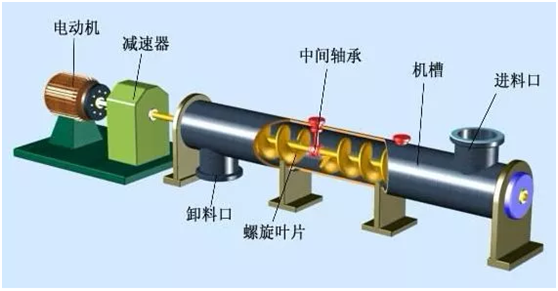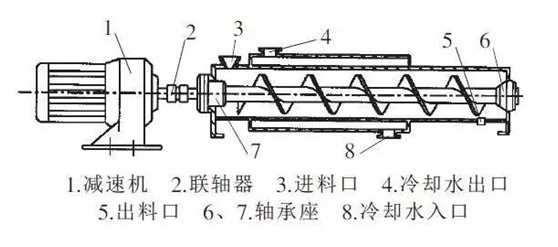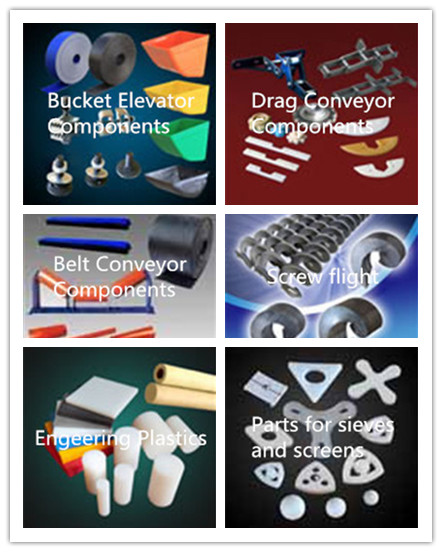The screw conveyor is simple in structure, small in area, easy to seal, does not generate dust, and is suitable for conveying fine powder and bulk materials; it is not suitable for conveying materials that are easily deteriorated, viscous, and easy to agglomerate.
The screw conveyor mainly includes a driving device motor, a reducer, a material chute, a screw shaft with spiral blades and supports at both ends, with a feeding port, a discharge port and an inspection port.
Common faults include loosening and fracture of coupling shaft bolts, tearing of spiral pieces, twisting of flange welds, and hollow shaft cracks. Once the screw conveyor fails, it will affect the progress of the entire production line, and it is important to do daily maintenance.

Screw conveyor blocking
Main reasons and treatment methods:
1) Reasonably choose the technical parameters of the screw conveyor, such as the speed of the slow screw conveyor should not be too large.
2) Strictly implement the operating procedures to achieve no-load start and no-load stop; ensure continuously and even feeding.
3) Enlarge the discharge port or lengthen the end of the trough to solve the problem of poor discharge or too late to discharge. At the same time, a small anti-rotation blade can be installed at the end of the trough of the discharge port to prevent material blocking at the end.
4) Necessary cleaning of materials entering the screw conveyor to prevent large debris or fibrous impurities from entering the machine and causing blockage.
5) Reduce the transverse dimension of the intermediate suspension bearing as much as possible to reduce the possibility of material blocking when the material passes through the intermediate bearing.
6) Install silo level device and blockage sensor to realize automatic control and alarm.
7) An anti-blocking valve is opened on the discharge end cover. When blockage occurs, due to the accumulation of materials, the anti-blocking door is opened, and the power supply is cut off through the travel switch.
The screw conveyor drive motor burned out
Main reason:
1) There are hard blocks or small iron blocks mixed in the materials conveyed by the screw conveyor, the reamer is stuck, the current increases sharply, and the motor is burned.
2) The incoming material is too large, and the motor is overloaded and heated and burned.
Approach:
1) Prevent small iron pieces from entering and keep a certain gap between the reamer and the casing.
2) Ensure that the feeding is balanced and deliver the materials before the shutdown.

Screw conveyor casing shakes
The main reason is that the center lines of the spiral sections are not concentric when the screw conveyor is installed, and the shell is eccentrically rubbed during operation, causing the shell to shake.
Solution: re-install and align the center line.
The temperature rise of the screw conveyor suspension bearing is too high
Main reason:
1) Improper installation.
2) Hard and large objects are mixed into the machine to cause abnormal friction.
Approach:
1) Adjust the position of the suspension bearing.
2) Clean up foreign objects and test run until normal.
Screw conveyor machine overflow
Main reason:
1) The material has a large moisture content, which is concentrated on the spiral crane bearing and gradually thickens, making it difficult for incoming materials to pass.
2) The sundries in the material block the screw crane bearing.
3) The transmission device failed and was not discovered in time.
Approach:
1) Strengthen the drying of raw materials.
2) Shut down the machine to remove the debris.
3) Shut down and repair the transmission device.
Loose, drop and break of screw shaft coupling bolts
The main reason: the intermittent force is uneven during operation, causing the bolt to loosen, fall or break due to impact.
Treatment method: Improve the strength of bolt connection.
Screw conveyor screw blade tearing
The main reason: foreign matter in the raw material can cause damage to the spiral blade. In severe cases, the weld between the spiral blade and the spiral shaft will be unwelded, resulting in a spiral blade tear. Treatment method: If the spiral blade is damaged, the quality and strength of the spare parts should be improved. When making spare parts, the consistency of the blade should be ensured. The welding seam should be dense and reliable to avoid defects such as slag and pores. Ensure the welding quality and improve the strength of the spiral shaft and the drive shaft.
Twisting of flange weld of screw conveyor
The main reason: due to abnormal torque, the welding of the coupling flange failed.
Solution: Whether it is flange connection or spline connection, the accuracy of the installation position of the spiral body must be ensured. After installation, wiring and debugging should be performed to determine whether the spiral direction is abnormal and the sound is abnormal.
After the test run, check the temperature rise of the motor, reducer, and bearing. When everything is normal, start the manual screw silo gate to gradually feed the material. After debugging, the screw runs smoothly.
Screw shaft crack
The main reason: due to long-term wear and tear, the torsional strength is reduced, and cracks and cracks are formed.
Approach:
1) Strengthen equipment maintenance to prevent the screw shaft from wearing and breaking, strictly control the quality of raw materials, and prevent foreign matter from entering the conveyor;
2) Lubricate the lubrication parts regularly;
3) Strengthen the inspection and maintenance of the drive device;
4) Perform regular inspections on the quality of the spiral blades. When the spiral blades are abnormally worn, the spiral shaft is deformed, and the strength is reduced, replace them in time and analyze the reasons to take preventive measures;
5) If the coupling is found to be loose, fasten it in time; check the abnormal phenomenon such as heating and noise in the operation of the equipment, clean up foreign objects, and repair the spiral or chute.
10. Screw shaft input shaft section fracture
The main reason: the screw conveyor is installed, the coaxiality of the screw shaft is out of tolerance or the safety factor is low when selecting the shaft.
Treatment method: To improve the shaft fracture of the screw conveyor, it is necessary to adjust the coaxiality, and use the stop positioning to ensure that the bearing housings on both sides of the cylinder are concentric; the shaft head is made of high-strength materials.
In actual production, it is necessary to do a good job of daily maintenance, and carry out equipment transformation and maintenance according to production needs. When the process changes and exceeds the equipment performance range, continued operation will cause rapid equipment damage, and even fail to meet the production process requirements, affecting normal production.
Yutung conveyor manufacture the screw conveyor, detailed please check www.ytconveyor.com

